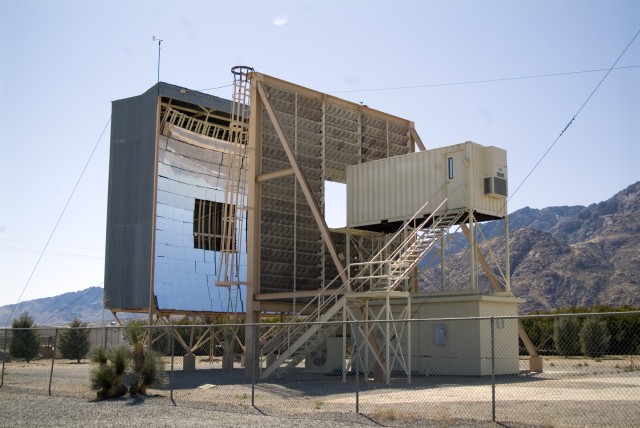
WHITE SANDS MISSILE RANGE, N.M. -- White Sands Missile Range test facilities are being used by scientists to develop methods for saving the world.
While the White Sands Missile Range Solar Furnace was originally built to test the survivability of Army systems and materials against the nuclear threat of the cold war, the facility is serving other purposes as well.
While initially designed for research and testing relating to nuclear survivability in July 2009, the furnace was used to test a theory on saving the world. A threat that has quietly hung above earth for millions of years in that of a meteorite large enough that its impact with earth would result in a disaster of a magnitude that it would cause the extinction of humanity.
The theory, presented by Purdue University Geophysicist Jay Melosh, was that should a meteor be spotted approaching earth then a spacecraft equipped with a system similar to that of the solar furnace could be launched to intercept the meteor.
Once it arrives at the meteor the spacecraft would deploy its system and use the power of the sun to superheat a spot on the meteor. The heat would cause that spot on the meteor to melt and fracture, throwing off small bits of debris; the force of which would act like a small rocket slowly pushing the meteor and changing its course.
"In theory it should work. If you put something in its space, its reverse force should push it in the opposite direction," said Randy Brady, chief of WSMR's Nuclear Effects Division.
To simulate this action, WSMR test officers placed slabs of green marble, a material Melosh selected for its similarity to meteors, into the solar furnace.
When exposed to the beam generated by the furnace, the marble reacted violently, melting and throwing off small chunks of rock, proving the theory and surprising some of the WSMR staff that worked on the project. "I didn't think you could melt rock," Brady said.
The facility operates on the simple principle of focusing the light and heat of the sun onto a four-inch diameter point, much the same way that a magnifying glass can.
The furnace uses two primary sets of mirrors, each several stories tall. One large flat set can pivot around to catch the rays of the sun and direct them though a shutter system into the second set of mirrors, which focus the light and heat onto the target.
In the target area, the temperature can get around 6,000 degrees Fahrenheit, though for test purposes the furnaces output uses a different measurement system to account for the amount of energy over time. "We don't really use temperature, we use calories per centimeter squared," Brady said.
Originally built in 1952 the furnace was moved from Natick, Mass., to White Sands in 1976. White Sands' remote location and typically clear skies help both ensure the secrecy of many of the furnace tests and helps keep the furnace operating efficiently. "The good thing here is that the sun is really easy to track and there aren't many clouds," Brady said. During a normal test the subject is placed in the target area and exposed to the heat of the system for only a few seconds at most, simulating the sudden heat put out by a nuclear explosion.
While the furnace still sees regular use, conducting around 10 tests a year, Brady hopes to see more scientific research conducted as the facility is extremely affordable to operate, costing only around $1,700 per day.

Social Sharing